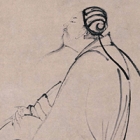Asian Gallery (Toyokan) Room 8
February 24, 2015 (Tue) - April 12, 2015 (Sun)
Known as "the land brimming with the air of kings," the ancient city of Nanjing (formerly known as Jinling) nourished a unique culture, which was central to China's Jiangnan region, from the Six Dynasties period, through the Ming and Qing dynasties, and into the modern period.
During the Song and Yuan dynasties, Nanjing developed as a sacred Buddhist site home to a sandalwood statue of the Buddha. Also flourishing as a center of Zen Buddhism, this city provided training for numerous Japanese monks. Nanjing temporarily served as the capital in the early Ming dynasty (1368-1644), and even after the relocation to Beijing, continued to grow as a secondary capital where unique painters enjoyed royal patronage.
During the turmoil at the end of the Ming and beginning of the Qing dynasties, Nanjing functioned as the spiritual capital of the exiled Ming government. As the Qing dynasty became established, a commercial district grew and a culture of publication initiated by the literati blossomed along the Qinhuai River, which runs through the city. In the 20th century, art universities were founded in Nanjing - then the capital of the Republic of China - at which painters who had returned from studies in Europe and Japan taught. Even today, this city attracts many and is continuously developing as a hub of culture and academia.
Nanjing has not gained as much attention as Beijing or Shanghai, yet it continues to play a significant role in the history of China's spiritual and philosophical culture. Covering over seven hundred years of painting and calligraphy associated with Nanjing, this exhibition is the first of its kind in Japan - a nation with deep connections to this city.

